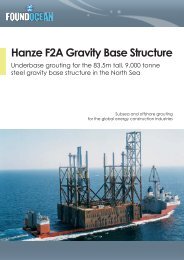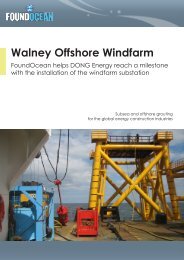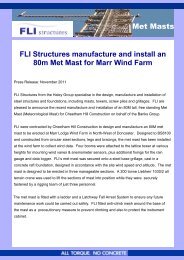UNEXPLODED ORDNANCE - Wind Energy Network
UNEXPLODED ORDNANCE - Wind Energy Network
UNEXPLODED ORDNANCE - Wind Energy Network
Create successful ePaper yourself
Turn your PDF publications into a flip-book with our unique Google optimized e-Paper software.
SPONSORS OF Unexploded Ordnance<br />
The legacy<br />
of conflict<br />
The legacy of Britain’s involvement in conflict<br />
continues to have an impact on commercial<br />
activities to this day<br />
Unexploded Ordnance (UXO) is<br />
encountered on a relatively frequent<br />
basis by companies involved in the<br />
construction or maintenance of<br />
offshore wind farms and other<br />
energy sectors.<br />
Potential risk<br />
The fact that there is a potential risk of<br />
UXO on these sites around the UK should<br />
not come as a surprise. The National<br />
Archive suggests that in excess of 60,000<br />
munitions remain unaccounted for in the<br />
North Sea alone.<br />
Other reports suggest that 1 in 10 of<br />
bombs dropped on the UK and its<br />
surrounding waters failed to detonate.<br />
Facing reality<br />
On the day all of this becomes relevant<br />
to your project due to a UXO discovery<br />
the question is what to do next When<br />
the project manager of a large wind farm<br />
construction project on the East coast had<br />
such a scenario he was initially unsure.<br />
Perhaps the military would<br />
help<br />
Unfortunately, they no longer provide<br />
a guarantee of support to commercial<br />
operations and do not undertake any work<br />
outside the 12 mile limit. Unless there is an<br />
immediate threat to life, a military response<br />
is extremely unlikely. Within 24hrs of<br />
being told this, the project manager called<br />
Ramora UK.<br />
Ramora UK<br />
Since 2004, Ramora UK has been<br />
working with the oil and gas sector to fill<br />
the gap left by the Ministry of Defence<br />
and also provide some technology based<br />
solutions to this complex problem.<br />
Case Study – UXO discovery<br />
Following a short telephone conversation,<br />
the Ramora UK Senior Explosives Officer<br />
was invited to an emergency meeting in<br />
Harwich. Less than six hours later, the<br />
meeting was underway and despite the<br />
aim being to gain an understanding of the<br />
options available, the outcome was an<br />
immediate mobilisation of the full Remote<br />
Explosive Ordnance Disposal System<br />
(REODS).<br />
Mobilisation<br />
Less than 36 hours after this initial meeting<br />
the full REODS system had been mobilised<br />
with vessel, Explosive Ordnance Disposal<br />
(EOD) team and ROV to undertake an initial<br />
assessment of the UXO.<br />
Skills and experience<br />
Utilising the skills and experience of former<br />
Royal Navy Clearance Divers, under the<br />
direction of a Mine Warfare and Clearance<br />
Diving Officer, the team are well versed in<br />
such operations and quickly determined<br />
the type of UXO and the disposal<br />
methodology.<br />
Equipment<br />
With all the equipment, including<br />
explosives, embarked as a standard<br />
protocol, the team had everything<br />
necessary to undertake the safe disposal<br />
of the munition with minimal fuss.<br />
34<br />
www.windenergynetwork.co.uk

















